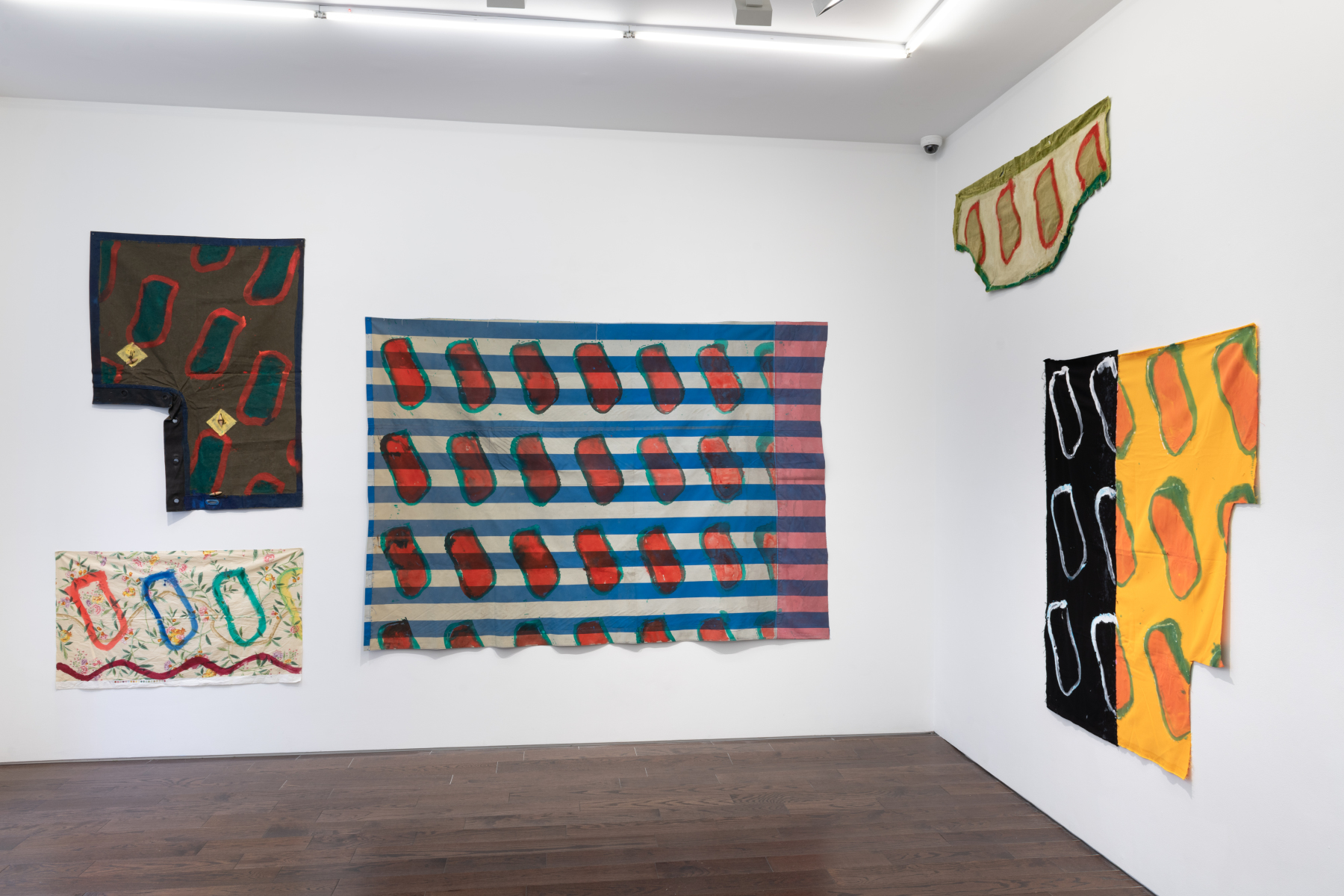Claude Viallat
Recent Works
September 08 - October 22, 2022
Claude Viallat
Recent Works
September 08 - October 22, 2022
We look at this group of Claude Viallat's paintings, standing before each of them with the memory of those works by him we have known since 1966, when he chose to repeat the same form on supports and canvases freed from the stretcher. There is within us this accumulation of memory in a lifetime of work developed day by day for more than half a century and whose origin melts into an even older temporality, that of caves, that time before painting, when man applied his hand flat on the stone walls and made of this trace, of this imprint, a fragile cry to mark his presence in the world.
We are in the solar blindness of this memory, that of a Mediterranean south where he paints; we are there, caught up in the sumptuousness of the color which makes other memory chords vibrate in us: the yellows and blues of Matisse, the Veronese greens, the velvet purple of chasubles, the flaming pink or the fiery red of bullfighting capes. We look at these canvases to detect something accidental, unexpected, and sometimes a little inappropriate; the surprise of a haphazard impregnation of color into the fabric—those parts where the color overflows and freezes in the overflowing layers of paint or, on the contrary, permeates deeply into the flatness of silence.We look at them for the flash of light in the white rings of the shapes or for the adventurous and liquid invasiveness of one color mixing with another. The uniqueness emerges despite the regular repetition of form: it appears from a patching of the canvas that Claude Viallat underlines or bypasses, from a casual fraying, from an intertwined rope retained by the eyelets, from a past passage inscribed in the very material of the support and with which he likes, jubilantly, to compose. All that is unpredictable and different in this obstinate bass-note in the work of a painter who has made repetition of the same form the basis of his pictorial practice––this "fruitful impasse" as he puts it––and which might be compared in another domain to the apparently repetitive music of Philip Glass and its imperceptible variations. Repetition, as we know, never leads to an identical replica, but summons up a discontinuity in the linear continuity of time; and it is indeed this relationship to time that Viallat, in his strange daily hand-to-hand encounter with it, expresses in his painting with strength and subtlety.
Every morning he leans over this canvas, "an arena for action,” and stands in expectation of a new discovery, a new astonishment, an overflowing, the anticipated happiness that keeps him alive. Every morning a new horizon rises on the still bare canvas, when all memory fades and everything comes closer. Everything becomes possible again on the carnal surface of the fabric, in the epiphanic surprise of a saturation entrusted to the liquid color.
We look at this recent series of fragments of military tarpaulins, thick supports that have suffered the assaults of time and light. Through the effects of exposure, the trace of the ropes that covered them has been inscribed on them as though they were a photographic plate; a visible memory of what was there and is no longer; a memory like that which can be found on the very old walls of abandoned houses where the presence of the paintings that adorned them can still be seen in the differentiated fading of the color. One thinks of Viallat's first works in the 1960s, of the experimentation with methylene blue, which the sun gradually attenuated until it disappeared. Nothing could have enchanted him more than to find the visible signs of this struggle between matter, sunlight, and time.We stand in front of them today whilst he has affixed his own shapes and colors to these tarpaulins, creating a double presence: that of the ropes themselves and that of their solarised memory marked on the fabric. He has sometimes covered these ghostly lines, but he has also chosen to go around them in order to leave them clearly visible, like another motif to accompany his own, recognizable among all. Sometimes nature's interventions impose this withdrawal and humility on the artist and the artists of Supports/Surfaces have often practiced it, letting rust, fire, or the sun act on the works. However, it can also happen that an artist wants to enter this combat to affirm, as Viallat does, the singular power of painting––that of a gesture that always seeks to modify, to transgress, to subvert the material, to provoke that visual pleasure which is always a little euphoric when on these poor supports, on the rusticity of recycled materials, on the roughness of tarpaulins diverted from their use and destined for the scrap heap, the sumptuous and sensual beauty of a southern sun where the exhilarating marriage of man and the world is celebrated.
Bernard Collet, 2022
Artist : Claude Viallat
Visitor Information
Ceysson & Bénétière
956 Madison Avenue
10021 New York
T: +1 646 678 3717











